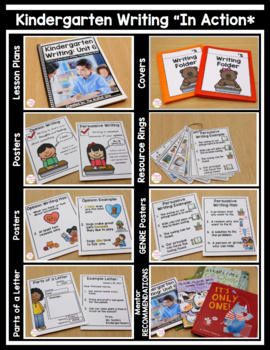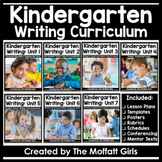Kindergarten Writing Curriculum: Opinion and Persuasive Writing
- Zip
What educators are saying
Also included in
- This bundle contains 7 writing units for a FULL year of writing curriculum! Also available:First Grade Writing Curriculum HERE***DOWNLOAD THE PREVIEW TO SEE THIS CURRICULUM IN ACTIONDo you struggle with teaching your students how to write? Do you feel like you need more confidence and guidance in tePrice $52.50Original Price $105.00Save $52.50
Description
SAVE BIG WITH THE GROWING BUNDLE
Kindergarten Writing Curriculum (The Bundle)
First Grade Writing Curriculum (The Bundle)
***DOWNLOAD THE PREVIEW TO SEE THIS CURRICULUM IN ACTION
Do you struggle with teaching your students how to write? Do you feel like you need more confidence and guidance in teaching writing? This Kindergarten Writing Curriculum has EVERYTHING you need to be successful with teaching writing!
What Units are Included in the Bundle?
- Unit 1: Personal Narrative: Sharing my Stories
- Unit 2: Non-Realistic Fiction: Using our Imagination
- Unit 3: Writing to Teach & Inform: How-to Books
- Unit 4: Poetry: Exploring Poetry
- Unit 5: Realistic-Fiction: Writing Interesting Stories
- Unit 6: Opinion & persuasive Writing: Changing the World
- Unit 7: Non-Fiction Chapter Books: Creating a Chapter Book (coming soon)
Included in Unit 6: Opinion and Persuasive Writing
Unit 6 Scope:
Lesson 1 Research: Introduction to opinion & persuasive writing
Lesson 2 Planning: Developing my opinion
Lesson 3 Planning: Supporting my opinion
Lesson 4 Writing: Drafting my opinion piece
Lesson 5 Revising: Using my resources
Lesson 6 Planning: Developing my opinion
Lesson 7 Planning: Supporting my opinion
Lesson 8 Writing: Drafting my opinion piece
Lesson 9 Revising: Using my resources
Lesson 10 Planning: Identifying my problem and why it matters
Lesson 11 Planning: Identifying a solution and who can help
Lesson 12 Writing: Drafting my persuasive letter
Lesson 13 Revising: Using powerful words and images
Lesson 14 Planning: Identifying my problem and why it matters
Lesson 15 Planning: Identifying a solution and who can help
Lesson 16 Writing: Drafting my persuasive letter
Lesson 17 Revising: Using powerful words and images
Lesson 18 Proofreading my best letter
Lesson 19 Getting & giving feedback
Lesson 20 Using feedback to edit my letter
Lesson 21 Publishing my letter
Lesson 22 End of unit celebration
*Lesson 23 Optional: Address and mail letters
How are the Units Designed?
Part 1: Pre-Unit On Demand
This quick writing task provides an an opportunity to assess prior knowledge. Use this writing sample to guide your teaching throughout the unit and measure growth.
Part 2: Lessons
Each lesson is broken up into 6 easy-to-follow parts.
- Focus- The skill, strategy, or idea students will be focusing on this lesson.
- Warm Up- A quick activity that has students review and practice previous skills.
- Mini Lesson- Teach, model, and discuss the new skill in today’s lesson.
- Practice-The hands-on portion of the lesson where students apply what they have learned in the mini lesson to their own writing. During this time you will conference individually with students.
- Mid-Practice Teaching Point-A quick reminder and chance to highlight the great work students are doing.
- Share- Lesson wrap up where students analyze, reflect on, and share their work.
Part 3: Final Writing Piece
The unit final writing piece is a published piece of writing that highlights everything the student learned in this unit.
Part 4: Post-Unit On Demand
This quick writing task provides an opportunity to assess progress and measure growth.
What Does a Lesson Look Like?
Depending on the time you have available for writing, I have suggested schedules for the following time blocks:
- 60 Minute Time Block
- 45 Minute Time Block
- 30 Minute Time Block
The Writing Process:
- Research- Learn about a style of writing or topic.Read and look at great books to get ideas
- Planning: Decide on a topic and plan out your ideas.
- Writing: Use your plan to help you write your story.
- Revising: Improve your writing by adding details.
- Proofreading: Check your work. Use your resources to help you.
- Feedback: Ask others to read your story and give you ideas of how to improve it!
- Editing: Use the feedback you got from others to help make your story even better!
- Publishing: Make a neat copy of your book that is ready to share with the world!
Also included in the Curriculum:
- Tips for Getting Started (Classroom and Material Organization and Procedures)
- Developmental Writing Stages
- Unit Text (Mentor Text) Guides
- Conferencing Guides
- Conferencing Planner
- Conferencing Tracker
- Assessment Guide
- Rubrics and Rubric Guide
- Multiple Writing Templates
- Publishing Party Guide
- Publishing Party Supplies
- Unit Posters
- Genre Specific Idea Chart
- The Writing Process Chart
- Peer Editing Checklist
- Young Author Award
- Writing Folder Covers
- Pencil Organization Labels
- Writers Library Labels
- Alphabet Chart (full and mini size)
- Letter Formation Chart (full and mini size)
- Alphabet Sounds Chart (full and mini size)
- Word Wall Personal Book (blank copy and sight word copy)
- We Are Authors Banner
- 3 Wordless Picture Books
- Black and White Version Included
- Bonus Templates for structured prompts
More Questions?
Feel free to email me at themoffattgirls@gmail.com
Be sure to follow the Moffatt Girls on:
- Visit my blog atThe Moffatt Girls Blog
- Follow me on Facebook
- Follow me on Instagram
- Join my private group, The Moffatt Girls-Engage Group, to see how other teachers, parents, and homeschoolers are using and organizing Moffatt Girl Curriculum and to see the FB LIVE for this curriculum!






